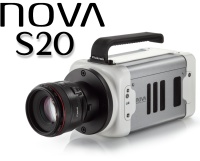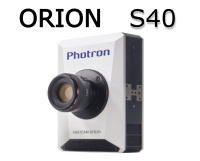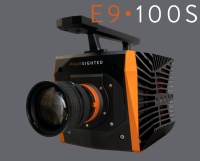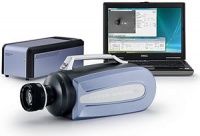- Description
- Specifications
- Videos
Cavitar Gen 2 CAVILUX 1000W pulsed laser illumination laser system promises superior performance compared to conventional lighting methods. The Cavilux Smart 1000W laser unit generates high-power pulses at 810 nm (invisible infrared) wavelengths up to 100,000Hz for 10 seconds with its standard control unit. Combined with its new UHS (Ultra High Speed) synchronization control unit, the Generation 2 pulse laser system can reach minimal pulse duration of 10 nanoseconds at limited power or 30ns at full power for 30 microsecond burst. CAVILUX Smart lasers are ideal light source for ultra-high speed camera imaging up to 10 million frames per second.
Improvements to the CAVILUX Smart 1000W lasers are its powerful pulsed diode laser illumination light source system with very short pulses and very high repetition rates. The CAVILUX's monochromatic light eliminates chromatic aberrations commonly found in white light systems. Light output is essentially monochromatic with low degree of coherence, which is ideal for illumination purposes as there are no chromatic aberrations or speckles.
What distinguishes the Gen2 CAVILUX Smart pulsed illumination systems is its fiber-coupled design, allowing flexible light delivery even in cramped industrial spaces. Additionally, the system features changeable illumination optics that can be configured for various applications including direct illumination, back illumination, and darkfield. Infrared illumination with the 1000W Smart 810 nm laser system diminishes color effects in monochrome images, enhancing contrast of colored objects and simplifying inspection.
Target applications include:
- Shockwaves
- Flows of particles, droplets, sprays
- Welding and Additive Manufacturing
- Ballistics
- Shadowgraphy
- Schlieren
|
|
| 1000W @ 810nm (+/-10nm) |
Related products
Export Disclaimer: Some goods on this site may be subject to US Export Regulations. Buyer agrees as one of the terms of purchase not to export such goods without having obtained and executed proper export licenses from the United States Government. Learn more.
Understanding the Main Features of Cavitar’s CAVILUX Smart and CAVILUX HF Pulsed Illumination Lasers


Wavelength and Spectral Characteristics
The wavelength of illumination plays a crucial role in machine vision systems. Selecting the correct wavelength enhances image contrast and reveals specific features that might otherwise remain invisible.
The CAVILUX's monochromatic light eliminates chromatic aberrations commonly found in white light systems. Moreover, unlike coherent laser sources that produce speckle patterns, CAVILUX's low-coherence design delivers clean, speckle-free illumination while maintaining the benefits of laser light.
Different wavelengths offer distinct advantages in machine vision applications:
- Infrared illumination (like CAVILUX's 810 nm option) diminishes color effects in monochrome images, enhancing contrast of colored objects and simplifying inspection.
- Visible red light (640 nm in CAVILUX) provides excellent contrast for many applications where visible illumination is preferred.
Ultimately, the monochromatic nature of laser illumination also allows for efficient filtering of thermal light, enabling clear visualization of extremely hot processes like welding, where traditional lighting is overwhelmed by the process's own emissions.
If visible light is necessary, then CAVILUX Smart 650nm and 300W CAVILUX HF 650nm is the standard products with visiable red illumination. The CAVILUX HF is equipped with a visible laser pointer beam (green light). Color cameras typically have an IR cut filter in front of the sensor which blocks 810 nm. Some cameras allow the removal of that filter and in this case CAVILUX 640nm and 810nm pulsed lasers can be used.
Fiber core diameter
CAVILUX Smart pulsed laser has a fiber core diameter of either 3mm or 5 mm, whereas CAVILUX HF pulse laser has a fiber core diameter of 1.5 mm. This means that CAVILUX HF has 4-11 times higher brightness than CAVILUX Smart. Higher brightness enables the illumination of a smaller area from a certain distance or, alternatively, the illumination of a certain area from a greater distance. CAVILUX Smart 200 W provides a higher brightness than CAVILUX Smart 400W if the illuminated area is smaller than 3 mm.
Motion Blur Reduction: 95% Improvement with Laser
Traditional lighting systems struggle with fast-moving objects, creating blurred images that lack precision. The CAVILUX laser system demonstrated a remarkable 95% reduction in motion blur compared to halogen illumination. This dramatic improvement stems from the laser's ability to generate extremely short pulses that effectively "freeze" motion regardless of camera shutter speed.
Unlike conventional lighting, where motion blur increases proportionally with object velocity, the CAVILUX system maintains image clarity at speeds that overwhelm traditional solutions. The laser pulses can be as brief as 50 nanoseconds, which is approximately 200 times shorter than the fastest exposure times achievable with most industrial cameras. Therefore, even when objects move at exceptional speeds, their positions remain fixed during the illumination period.
Minimum pulse duration
The minimum pulse duration for CAVILUX Smart enabling full output power is ~30 ns. CAVILUX Smart can create pulse durations up to 10 ns but then the output power is lower. The minimum pulse duration for CAVILUX HF at full power is ~100 ns and 50 ns at lower output power. A very short pulse may be needed for removing motion blur when a small and fast-moving object is studied at high magnification. CAVILUX Smart has shorter rise and fall times than CAVILUX HF. Therefore, Smart can generate extremely short pulses (below 100 ns) more accurately than CAVILUX HF.
The CAVILUX system's flexibility in pulse duration settings enabled optimization for different applications—shorter pulses for ultra-high-speed phenomena and slightly longer pulses for applications requiring greater illumination intensity. Indeed, the system demonstrated that in accordance with two-photon absorption principles, shorter pulses required significantly less average optical power to achieve equivalent visibility.
For real-time monitoring applications requiring continuous imaging, the laser's high maximum duty cycle supported frame rates up to several MHz for brief periods, outperforming traditional lighting solutions in both speed and clarity.
Maximum duty cycle
Due to the difference in duty cycles CAVILUX Smart laser is typically used together with machine vision cameras and CAVILUX HF laser with high speed cameras. CAVILUX Smart laser may also be compatible with certain ultra high speed cameras, depending on the application and camera with short record buffers.
As an example, if the object doesn’t emit thermal light and 100 ns pulses are sufficient for illuminating the object, CAVILUX Smart laser can provide optimal results up to 10 kHz, independent of the minimum exposure time of the camera.
However, if the object emits thermal light (e.g. arc welding), it is usually important that the laser pulse is of similar duration than the camera exposure time (and that the camera exposure time is properly synchronized with the laser pulse). In such a situation, having a camera of 1 µs minimum exposure time, CAVILUX Smart laser can provide optimal results up to 1 kHz (provided that the synchronization between the camera and the laser can be realized properly). Most likely acceptable results can be achieved also at somewhat higher frame rates (up to a few kHz), but the whole camera exposure time won’t be covered by laser illumination anymore (thus making the effects of thermal light stronger than in an ideal situation).
Applications:
Some examples of high-speed video cameras with short-pulse diode lasers include:
- Welding
- Additive manufacturing
- High voltage switching circuits
- Flow visualization
- Ballistics
- Impact visualization
- Shock wave analysis
- Spray visualization
- Schlieren
- Shadowgraphy





